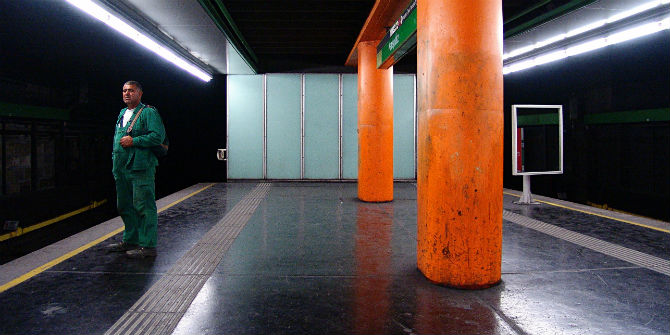 One in ten NHS doctor posts are vacant – yet foreign-trained medics already make up nearly 29% of the workforce. Although Theresa May has said EU-born doctors working here may stay until enough Britons are trained to replace them, recruiting and keeping staff is likely to become more difficult because of the uncertainty surrounding their future immigration status. Victoria Simpkin says NHS workers need clarity now and any work permit scheme must give priority to shortage occupations in the NHS.
One in ten NHS doctor posts are vacant – yet foreign-trained medics already make up nearly 29% of the workforce. Although Theresa May has said EU-born doctors working here may stay until enough Britons are trained to replace them, recruiting and keeping staff is likely to become more difficult because of the uncertainty surrounding their future immigration status. Victoria Simpkin says NHS workers need clarity now and any work permit scheme must give priority to shortage occupations in the NHS.
The NHS is already understaffed, with the UK having 2.8 practising doctors per 1,000 population in 2013, below the OECD average of 3.3 (OECD: Health at a Glance 2015). ‘Underfunded, underdoctored, overstretched’ is a report by the Royal College of Physicians, launched in September, which describes the challenges that are facing the NHS. It paints a bleak picture of a service struggling to cope under the increasing pressure of rising demand and inadequate funding, with workforce pressures threatening patient safety. Seven out of ten doctors-in-training are working on a rota with a permanent gap in staffing and hospitals are failing to fill two in every five consultant physician posts they advertise.

The UK does not train enough doctors and nurses, and relies on immigration to staff the NHS. In absolute numbers, the UK has the second-highest number of foreign-trained doctors after the US, with more than 48,000 foreign-trained doctors in 2014. Most of these are from Asian countries, with India leading by a wide margin, but growing numbers come from other EU countries. Looking at the share of foreign-trained doctors in OECD countries in 2013, at 28.7% the UK is well above the OECD average; the only countries higher are Israel, New Zealand, Norway, Ireland and Australia. Despite this additional support from overseas trained staff there is still a 10% vacancy rate among doctors in the NHS. With this in mind, we need to consider what impact triggering Article 50 will have on these doctors.
No one is certain what will happen to EU citizens who are currently residing in the UK and those who may wish to work here in the future once the UK triggers Article 50. Under EU free movement law, EU citizens are currently able to move without the need to complete substantial amounts of paperwork. But after invoking Article 50 the rights of EU migrant healthcare professionals working in the UK are likely to change, including the regulatory requirements imposed by the General Medical Council for these doctors.
The health secretary Jeremy Hunt intends to increase domestic training efforts in order to make the NHS ‘self-sufficient’. The aim is to increase the number of ‘homegrown’ doctors by increasing the number of medical school places by 25% (1,500 students per annum) by 2018. Given that medical degrees take at least five years to complete, it will be 2024 before any of the impact of these extra places is felt.
While Theresa May has said in an interview that EU staff will be allowed to stay for an interim period until there are enough homegrown doctors, it is not clear what their status will be after this time. Furthermore, the UK is already a less attractive place in which to practice medicine and many EU-trained staff may leave the UK pre-emptively due to the uncertainty created when the migration restriction is imposed. There is already anecdotal evidence from hospitals across the country that EU applicants have pulled out of consultant posts following the referendum.
There have been talks about different models for EU migrant workers coming to the UK, including work permits. These could require EU migrants to have a job prior to entering the country.
The Department of Health has said that the health service will struggle and a seven-day service – a key Conservative manifesto pledge – may no longer be possible without the doctors and nurses from EU countries. The Institute for Public Policy Research has warned the UK may face a ‘public health emergency’ and see the NHS collapse if EU staff return home.
A further sticking point is the current junior doctor crisis. The dispute over junior doctors’ contracts has increased the number of doctors who are leaving the system, either to other countries such as Australia, New Zealand and Canada or to careers outside of medicine. One plan to combat this is the proposal that newly trained doctors must now work for the NHS for four years after graduation or have to pay back the over £200,000 invested in their training.
It is crucial that the government is transparent and clearly communicates its plans for EU workers in the coming months. If a work permit scheme is introduced, priority needs to be given to those working in designated ‘shortage’ occupations such as doctors and nurses. The foreign-trained workers who are sustaining the NHS must have their jobs safeguarded and the NHS must be made an attractive place to work for both ‘homegrown’ workers and those workers from overseas.
This post represents the views of the author and not those of the Brexit blog, nor the LSE.
Victoria Simpkin is a cardiology registrar and a Research Officer at the LSE.







“If a work permit scheme is introduced, priority needs to be given to those working in designated ‘shortage’ occupations such as doctors and nurses.”
Is this not already the case for non-EU immigrants anyway? We do already have non-EU immigrants working as doctors (and in every other role) – and a little Googling would have confirmed this: “The Tier 2 Skilled Worker category is for people with a job offer in the UK, coming to fill a gap in the UK labour force that cannot be filled by someone already in the country.” (Or Tier 1, for highly skilled professionals.)
I found this particularly grating in the run-up to the referendum, Remain advocates seeming to assume that all immigration was EU, as if removing the EU/non-EU discrimination would automatically mean a complete ban on immigration, that we’d suddenly start having to apply in advance for travel to EU countries … there is a lot more on this planet than the EU!
Hunt’s moves to increase the number of MBChB places should surely be welcomed as long-overdue, rather than criticised: we are short of doctors and not training enough at present, after all. Likewise, trying to recoup training costs is hardly unreasonable: train as a pilot in the RAF, you have to fly RAF planes for a certain number of years before you can go off to fly for Easyjet using that RAF training – why shouldn’t other professions be similar?